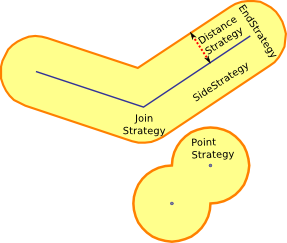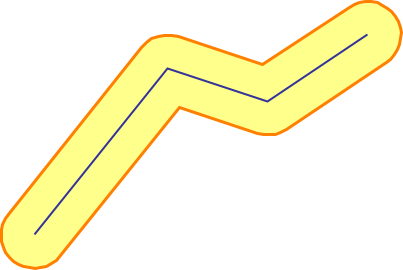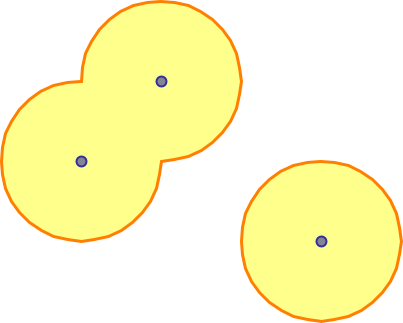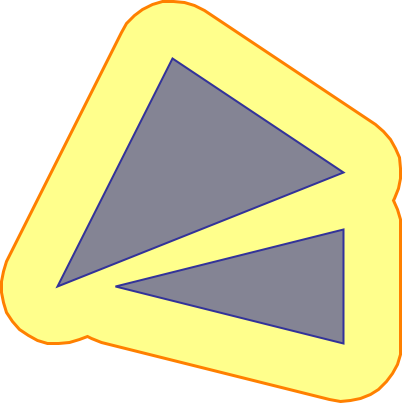 Boost
C++ Libraries
Boost
C++ Libraries
...one of the most highly
regarded and expertly designed C++ library projects in the
world.
— Herb Sutter and Andrei
Alexandrescu, C++
Coding Standards
 Boost
C++ Libraries
Boost
C++ Libraries
...one of the most highly
regarded and expertly designed C++ library projects in the
world.
— Herb Sutter and Andrei
Alexandrescu, C++
Coding Standards
Calculates the buffer of a geometry.
The free function buffer calculates the buffer (a polygon being the spatial point set collection within a specified maximum distance from a geometry) of a geometry.
template<typename GeometryIn, typename MultiPolygon, typename DistanceStrategy, typename SideStrategy, typename JoinStrategy, typename EndStrategy, typename PointStrategy> void buffer(GeometryIn const & geometry_in, MultiPolygon & geometry_out, DistanceStrategy const & distance_strategy, SideStrategy const & side_strategy, JoinStrategy const & join_strategy, EndStrategy const & end_strategy, PointStrategy const & point_strategy)
|
Type |
Concept |
Name |
Description |
|---|---|---|---|
|
GeometryIn const & |
Any type fulfilling a Geometry Concept |
geometry_in |
A model of the specified concept |
|
MultiPolygon & |
A type fulfilling the MultiPolygon Concept |
geometry_out |
output multi polygon (or std:: collection of polygons), will contain a buffered version of the input geometry |
|
DistanceStrategy const & |
A strategy defining distance (or radius) |
distance_strategy |
The distance strategy to be used |
|
SideStrategy const & |
A strategy defining creation along sides |
side_strategy |
The side strategy to be used |
|
JoinStrategy const & |
A strategy defining creation around convex corners |
join_strategy |
The join strategy to be used |
|
EndStrategy const & |
A strategy defining creation at linestring ends |
end_strategy |
The end strategy to be used |
|
PointStrategy const & |
A strategy defining creation around points |
point_strategy |
The point strategy to be used |
Either
#include <boost/geometry.hpp>
Or
#include <boost/geometry/algorithms/buffer.hpp>
The 5 strategies give the user control to the generated buffer
By specifying a negative distance for the distance_strategy, for the (multi) polygon case, the polygon will be smaller (also known as deflate). The distance cannot be 0.
The next figure shows where in the generated buffer the strategies have effect

The function buffer implements function Buffer from the OGC Simple Feature Specification.
It is conformant if used with the following combination of strategies: join_round, end_round, distance_symmetric, point_circle, side_straight
|
2D Cartesian |
Geographic |
|
|---|---|---|
|
Point |
|
|
|
Segment |
|
|
|
Box |
|
|
|
Linestring |
|
|
|
Ring |
|
|
|
Polygon |
|
|
|
MultiPoint |
|
|
|
MultiLinestring |
|
|
|
MultiPolygon |
|
|
Shows how the buffer algorithm can be used to create a buffer of a linestring, a multi point, a multi polygon
#include <boost/geometry.hpp> #include <boost/geometry/geometries/point_xy.hpp> #include <boost/geometry/geometries/geometries.hpp> int main() { typedef double coordinate_type; typedef boost::geometry::model::d2::point_xy<coordinate_type> point; typedef boost::geometry::model::polygon<point> polygon; // Declare strategies const double buffer_distance = 1.0; const int points_per_circle = 36; boost::geometry::strategy::buffer::distance_symmetric<coordinate_type> distance_strategy(buffer_distance); boost::geometry::strategy::buffer::join_round join_strategy(points_per_circle); boost::geometry::strategy::buffer::end_round end_strategy(points_per_circle); boost::geometry::strategy::buffer::point_circle circle_strategy(points_per_circle); boost::geometry::strategy::buffer::side_straight side_strategy; // Declare output boost::geometry::model::multi_polygon<polygon> result; // Declare/fill a linestring boost::geometry::model::linestring<point> ls; boost::geometry::read_wkt("LINESTRING(0 0,4 5,7 4,10 6)", ls); // Create the buffer of a linestring boost::geometry::buffer(ls, result, distance_strategy, side_strategy, join_strategy, end_strategy, circle_strategy); // Declare/fill a multi point boost::geometry::model::multi_point<point> mp; boost::geometry::read_wkt("MULTIPOINT((3 3),(4 4),(6 2))", mp); // Create the buffer of a multi point boost::geometry::buffer(mp, result, distance_strategy, side_strategy, join_strategy, end_strategy, circle_strategy); // Declare/fill a multi_polygon boost::geometry::model::multi_polygon<polygon> mpol; boost::geometry::read_wkt("MULTIPOLYGON(((0 1,2 5,5 3,0 1)),((1 1,5 2,5 0,1 1)))", mpol); // Create the buffer of a multi polygon boost::geometry::buffer(mpol, result, distance_strategy, side_strategy, join_strategy, end_strategy, circle_strategy); return 0; }


